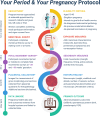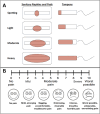Your period and your pregnancy, a cohort study of pregnant patients investigating the associations between menstruation and birth outcomes in Australia: study protocol
- PMID: 39843375
- PMCID: PMC11784170
- DOI: 10.1136/bmjopen-2024-091813
Your period and your pregnancy, a cohort study of pregnant patients investigating the associations between menstruation and birth outcomes in Australia: study protocol
Abstract
Introduction: Early pregnancy care involves the screening and identification of women with risk factors for adverse pregnancy outcomes, including stillbirth or preterm birth, to tailor pregnancy care and interventions accordingly. Most stillbirths and approximately two-thirds of preterm births, however, occur in the absence of evident risk factors. The majority of stillbirths occur in the preterm period, yet there are few interventions targeting this period, and progress to reduce stillbirth rates remains slow. Placental dysfunction is a major contributor to stillbirth, particularly, preterm stillbirth. Here, the endometrial environment may shed light on factors that influence placental development and the trajectory of a pregnancy. Menstrual symptoms or abnormal uterine bleeding (AUB) can indicate endometrial disorders, which are associated with infertility and adverse pregnancy outcomes. Whether AUB is associated with pregnancy outcomes in the absence of a diagnosed endometrial pathology, however, remains unknown. Limited information regarding a woman's menstrual cycle is captured in routine early pregnancy assessments, such as the last menstrual period and menstrual cycle length. Given the latent diagnosis of endometrial disorders and that up to a third of all women experience AUB during their lifetime, determining the association between menstrual characteristics and pregnancy outcomes has the potential to uncover new clinical strategies to reduce adverse pregnancy outcomes. Therefore, this study aims to understand the association between menstruation and pregnancy outcomes to identify which menstrual characteristics could provide value as a pregnancy risk assessment tool.
Methods and analysis: This is a prospective study of women aged 18-45 with a singleton pregnancy. Participants will be recruited in early pregnancy at their antenatal appointment and not have a known diagnosed endometrial pathology (endometriosis, adenomyosis, endometrial cancer or an endometrial submucosal fibroid) or have had an endometrial ablation. Participants will also be excluded if there is a planned termination of pregnancy or a termination of pregnancy for psychosocial reasons. Women will complete a menstrual history survey to capture menstrual cycle length, regularity, level of pain, heaviness of flow and other menstrual symptoms. Participants will consent to having the survey data linked with their pregnancy and birth outcome information. The primary outcome is a composite of stillbirth, spontaneous preterm birth, pre-eclampsia or fetal growth restriction. Participants will also be invited to complete an optional fetal movements survey at 28-32 and 36+ weeks' gestation, and consent for placental collection at the time of birth will be sought.
Ethics and dissemination: Ethics approval was obtained from Monash Health Human Research Ethics Committee (83559) on 24 April 2024. The study will be conducted in accordance with these conditions. Findings will be disseminated through peer-reviewed publications and conference presentations.
Keywords: Dysmenorrhea; Fetal medicine; GYNAECOLOGY; OBSTETRICS; PUBLIC HEALTH; Pregnancy.
© Author(s) (or their employer(s)) 2025. Re-use permitted under CC BY. Published by BMJ Group.
Conflict of interest statement
Competing interests: None declared.
Figures
Similar articles
-
Endometrial Origins of Stillbirth (EOS), a case-control study of menstrual fluid to understand and prevent preterm stillbirth and associated adverse pregnancy outcomes: study protocol.BMJ Open. 2023 Jul 11;13(7):e068919. doi: 10.1136/bmjopen-2022-068919. BMJ Open. 2023. PMID: 37433731 Free PMC article.
-
Reductions in stillbirths and preterm birth in COVID-19-vaccinated women: a multicenter cohort study of vaccination uptake and perinatal outcomes.Am J Obstet Gynecol. 2023 May;228(5):585.e1-585.e16. doi: 10.1016/j.ajog.2022.10.040. Epub 2022 Nov 3. Am J Obstet Gynecol. 2023. PMID: 36336084 Free PMC article.
-
Effect of telehealth-integrated antenatal care on pregnancy outcomes in Australia: an interrupted time-series analysis.Lancet Digit Health. 2023 Nov;5(11):e798-e811. doi: 10.1016/S2589-7500(23)00151-6. Lancet Digit Health. 2023. PMID: 37890903
-
Investigating Menstruation and Adverse Pregnancy Outcomes: Oxymoron or New Frontier? A Narrative Review.J Clin Med. 2024 Jul 29;13(15):4430. doi: 10.3390/jcm13154430. J Clin Med. 2024. PMID: 39124698 Free PMC article. Review.
-
The role of decidual cells in uterine hemostasis, menstruation, inflammation, adverse pregnancy outcomes and abnormal uterine bleeding.Hum Reprod Update. 2016 Jun;22(4):497-515. doi: 10.1093/humupd/dmw004. Epub 2016 Feb 23. Hum Reprod Update. 2016. PMID: 26912000 Free PMC article. Review.
References
-
- United nations inter-agency group for child mortality estimation (UN IGME) New York: 2020. A neglected tragedy: the global burden of stillbirths.
MeSH terms
LinkOut - more resources
Full Text Sources
Medical
Miscellaneous


